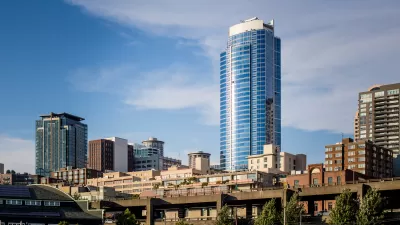To preserve views, zoning rules from 2006 require adequate distance between residential towers of a certain height. As developers chafe against the restriction, residents still worry they'll be left facing a wall.

Another symptom of Seattle's success: limited access to a decent view. Condos boasting picture-window vistas a decade ago lose their allure when an even taller residential tower goes up 20 feet away.
Seattle has taken steps to prevent that from happening. "The city's tower-spacing rule, which governs a large swath of downtown, was adopted nearly a decade ago to preserve views and daylight in an increasingly dense downtown [...] When the city overhauled the zoning code in 2006, it allowed developers to build denser, higher towers in downtown's mixed-use areas."
"To prevent streets from becoming walled corridors that block out light and views, and make pedestrians feel like they're in a wind tunnel, the city required that new towers over 160 feet high be 60 to 200 feet away, depending on the part of downtown, from other existing or permitted ones." Unfortunately, or fortunately, depending on how you look at it, this rule puts adjacent developers into competition for the permit to build higher. "Even small delays by either side can lead to being second in line for a tower permit and huge lost opportunities [...]"
Still, the tower-spacing rule enjoys public support. "Some residents of other downtown areas where the tower-spacing rules don't apply wish they had such restrictions. They say they live in fear of having a tower built a stone's throw from their window." To address those fears, some developers are experimenting with the podium-style developments (wide base, often with retail, and a thin, glassy tower on top) that have seen success in Vancouver.
FULL STORY: Rules preserving city views set up clash among towers competing to be first, biggest

Planetizen Federal Action Tracker
A weekly monitor of how Trump’s orders and actions are impacting planners and planning in America.

Congressman Proposes Bill to Rename DC Metro “Trump Train”
The Make Autorail Great Again Act would withhold federal funding to the system until the Washington Metropolitan Area Transit Authority (WMATA), rebrands as the Washington Metropolitan Authority for Greater Access (WMAGA).

The Simple Legislative Tool Transforming Vacant Downtowns
In California, Michigan and Georgia, an easy win is bringing dollars — and delight — back to city centers.

The States Losing Rural Delivery Rooms at an Alarming Pace
In some states, as few as 9% of rural hospitals still deliver babies. As a result, rising pre-term births, no adequate pre-term care and harrowing close calls are a growing reality.

The Small South Asian Republic Going all in on EVs
Thanks to one simple policy change less than five years ago, 65% of new cars in this Himalayan country are now electric.

DC Backpedals on Bike Lane Protection, Swaps Barriers for Paint
Citing aesthetic concerns, the city is removing the concrete barriers and flexposts that once separated Arizona Avenue cyclists from motor vehicles.
Urban Design for Planners 1: Software Tools
This six-course series explores essential urban design concepts using open source software and equips planners with the tools they need to participate fully in the urban design process.
Planning for Universal Design
Learn the tools for implementing Universal Design in planning regulations.
Smith Gee Studio
City of Charlotte
City of Camden Redevelopment Agency
City of Astoria
Transportation Research & Education Center (TREC) at Portland State University
US High Speed Rail Association
City of Camden Redevelopment Agency
Municipality of Princeton (NJ)




























